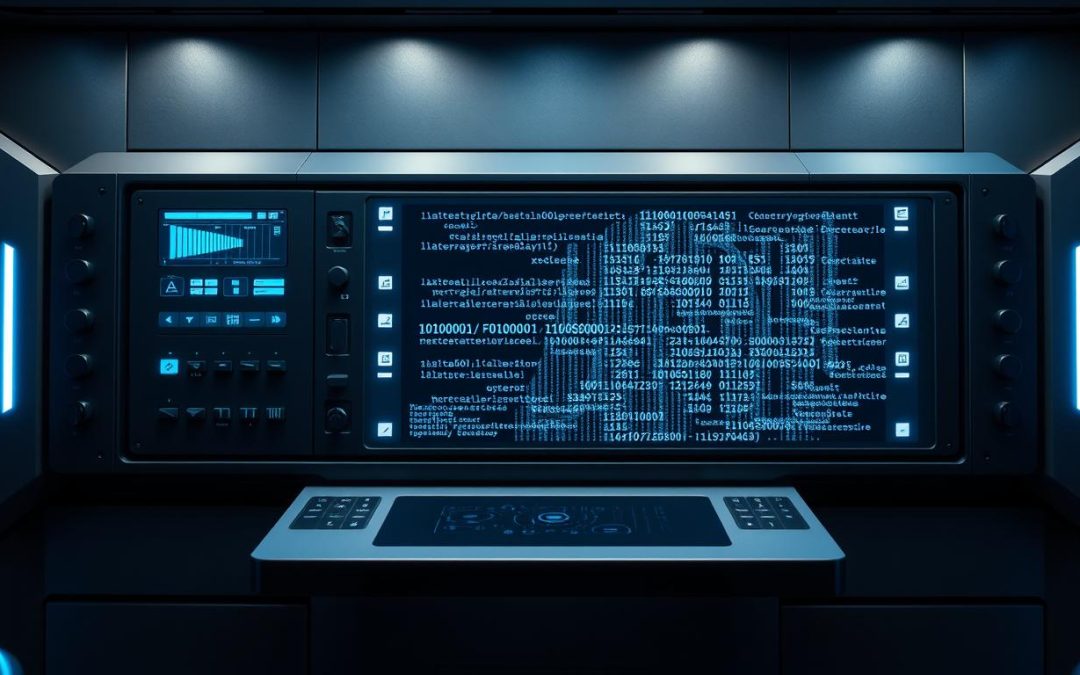Software developers use powerful tools to understand compiled apps. A decompiler changes binary code into source code. This lets developers see how complex software works.
Today’s binary to source code converters are key. They connect machine code to programming languages we can read. These tools help software engineers find ways to make software better.
Cybersecurity experts, software maintainers, and reverse engineers use decompilers. They analyze software, find bugs, and rebuild original code with great detail.
Key Takeaways
- Binary to source code converters translate machine code into readable programming languages
- Decompilers are critical for software analysis and reverse engineering
- These tools help developers understand complex software architectures
- Online converters provide convenient access to advanced code transformation technologies
- Software security researchers extensively use binary code conversion techniques
Understanding Binary to Source Code Conversion
Binary translation is key in software making. It turns machine code into source code we can read. This complex process lets developers make complex binary files into understandable programming languages.
The process of code reconstruction uses advanced techniques. These methods connect machine-level instructions to programming languages we can read. Developers use special tools to make binary data understandable.
Basic Principles of Binary Translation
Binary translation is about decoding machine instructions. It involves several important steps:
- Identifying machine-specific instruction sets
- Mapping binary patterns to programming constructs
- Keeping the original logic during conversion
- Handling platform-specific architectural differences
Role of Decompilers in Code Conversion
Decompilers are vital in binary translation. They analyze executable files and pull out source code. These tools reverse-engineer compiled programs, helping developers grasp the underlying algorithms and structures.
Machine Code to Human-Readable Format
Turning machine code into programming languages is complex. It needs advanced algorithms. This process requires a deep understanding of:
- Instruction set architectures
- Memory management techniques
- Computational logic reconstruction
- Semantic interpretation of machine instructions
Effective binary translation lets software experts analyze, maintain, and improve complex systems with great accuracy.
Benefits of Using Online Binary to Source Code Converters
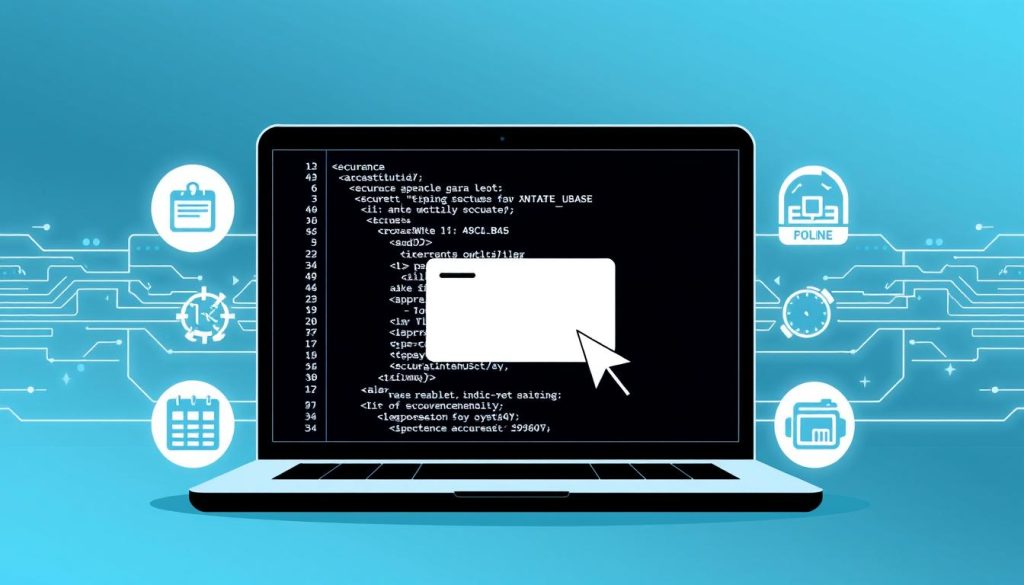
Online binary to source code converters have changed the game in software development and security. They give developers and security experts the tools they need to understand and analyze complex software systems.
Using these converters offers many benefits:
- Enhanced software security through quick code analysis
- Easy access without the need for complex software installations
- A cost-effective way to develop and reverse engineer software
- It makes teamwork easier for development teams
Developers get a lot from these converters. They can turn binary code into source code fast. This helps with debugging, finding vulnerabilities, and keeping old systems running.
| Converter Type | Primary Benefit | Use Case |
|---|---|---|
| Web-Based Binary Converter | Instant Code Translation | Quick Security Analysis |
| Cloud-Enabled Decompiler | Scalable Processing | Large-Scale Software Evaluation |
| Multi-Language Converter | Cross-Platform Compatibility | Diverse Development Environments |
Security experts love these converters for fast malware analysis and spotting vulnerabilities. They are a key part of keeping software safe today.
Key Features of Modern Decompilation Tools
Decompiler technology has changed how we analyze binary files. It turns machine code into source code we can understand. These tools help developers and security experts to see and rebuild complex software.
Today, decompilation tools are key in software making and security. They have advanced features. These let experts explore complex binary files with great detail.
Automated Code Analysis Capabilities
Top decompilers use smart algorithms to break down binary files. They find important code structures. Key features include:
- Structural code reconstruction
- Algorithmic pattern recognition
- Semantic understanding of machine instructions
- Automatic type inference
Multi-Language Support
Now, tools for binary analysis support many programming languages. This makes them very flexible for developers.
| Programming Language | Decompilation Support | Complexity Level |
|---|---|---|
| C/C++ | High | Advanced |
| Java | Excellent | Intermediate |
| Python | Good | Basic |
Debug Information Recovery
Modern decompilers can bring back debug info from binary files. This lets developers understand complex software without the original source code.
“Decompilation transforms cryptic machine instructions into readable, analyzable code.” – Software Engineering Insights
How Binary to Source Code Converter Works

A binary to source code converter changes low-level machine instructions into code we can read. It does this through a detailed, multi-step process. The process breaks down compiled programs into parts we can understand, showing their logic and structure.
The main steps in converting binary to source code are:
- Initial binary file parsing
- Instruction set identification
- Machine code translation
- Semantic reconstruction
- High-level code generation
Executable disassembly uses complex algorithms to break down binary files. These tools look at the machine code’s patterns. They find function boundaries, control flow, and data references with great accuracy.
“Transforming binary code into human-readable source is like deciphering a complex cryptographic puzzle.” – Software Reverse Engineering Expert
Today’s binary to source code converters use advanced methods like:
- Static analysis algorithms
- Dynamic runtime tracking
- Machine learning pattern recognition
- Intelligent code reconstruction
Developers face challenges like dealing with complex instruction sets. They also struggle with incomplete debug information and keeping code meaning intact during conversion.
Common Applications in Software Development
Converting binary to source code is key in today’s software world. It gives developers tools to understand and better existing software. These methods are vital for software engineering and upkeep.
Developers use binary to source code converters for many important reasons. They help with:
- Reverse engineering old systems with complex designs
- Doing thorough software security checks
- Spotting software vulnerabilities
- Handling software updates and upkeep
Reverse Engineering Legacy Systems
Reverse engineering lets developers peek into older software systems. When the original code is lost, these tools help rebuild and grasp complex systems. This ensures the system works well and can be updated.
Security Analysis and Vulnerability Assessment
Checking software security means looking closely at executable code. Binary to source code converters turn machine code into something humans can read. This lets experts find hidden security risks in compiled apps.
Software Maintenance and Updates
Keeping software up to date needs a deep understanding of the code. These tools make updates easier by showing developers how the software is built. This helps in making fixes, improving performance, and enhancing the system.
Best Practices for Binary Decompilation

Working with binary decompilation is complex. It needs careful planning and a deep understanding of decompiler tools. Professionals must know how to use these tools well.
Developers should follow some key best practices for binary decompilation:
- Select robust decompiler tools with proven track records
- Validate code reconstruction results through multiple verification methods
- Understand the specific constraints of different programming environments
- Maintain comprehensive documentation of decompilation processes
Experts know that code reconstruction is more than just using tools. Manual intervention and critical analysis are key to understanding decompiled files. The best results come from combining automated scanning with human insight.
Precision in binary analysis demands both technological sophistication and meticulous human oversight.
Having a clear workflow helps avoid mistakes in decompilation. Developers should focus on:
- Comprehensive binary file preparation
- Systematic code analysis
- Cross-referencing decompilation results
- Rigorous error checking
By using these strategies, software experts can improve their decompilation work. They can keep the code quality and accuracy high.
Security Considerations in Binary Analysis
Binary analysis is key in cybersecurity. It helps find and understand threats. Experts use advanced methods to spot risks in files.

Companies face big challenges in binary analysis. They must carefully explore complex security areas and find vulnerabilities.
Malware Detection and Analysis Strategies
There are several ways to analyze malware:
- Spotting odd code patterns
- Identifying possible threats
- Studying how files act in safe places
- Getting important threat info
Protective Measures During Decompilation
Security experts need strong plans for binary analysis:
- Use sandboxed areas
- Keep networks isolated
- Have advanced monitoring tools
- Keep detailed logs
Legal and Ethical Considerations
Working in binary analysis means following the law and ethics. Intellectual property rights and ethical rules are crucial in reverse engineering or malware studies.
It’s important to follow responsible disclosure and respect legal limits in cybersecurity.
Experts must weigh technical skills against legal and ethical rules. This ensures binary analysis helps security without harming rights.
Choosing the Right Binary to Source Code Converter
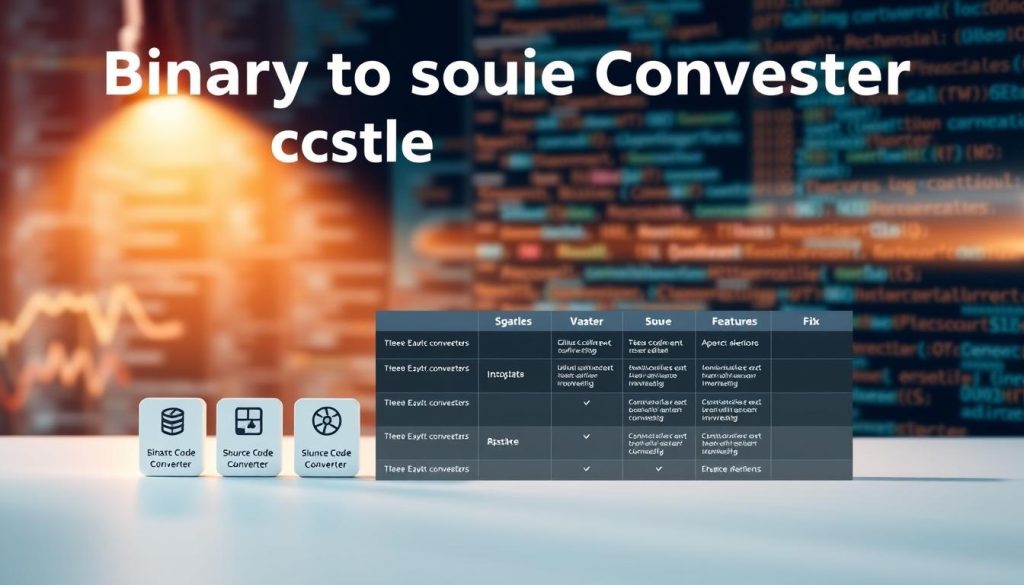
Choosing the right binary to source code converter is important. It helps turn executable files into code that’s easy to read. This makes it easier for developers and researchers to work with.
When picking a converter, there are key things to look at:
- Supported file formats and architectures
- Code reconstruction accuracy
- User interface complexity
- Performance and processing speed
- Community support and documentation
Compatibility is key when choosing a conversion tool. Different converters work better in different environments. It’s important to find one that fits your project needs.
For executable disassembly, consider these points:
- Precision of code translation
- Handling of complex compiled languages
- Support for debugging information recovery
- Integration capabilities with existing development workflows
Experts suggest trying out different tools. Look for ones that support many languages and have strong analysis features.
The right binary to source code converter can dramatically simplify reverse engineering and software maintenance processes.
Advanced Techniques in Executable Disassembly
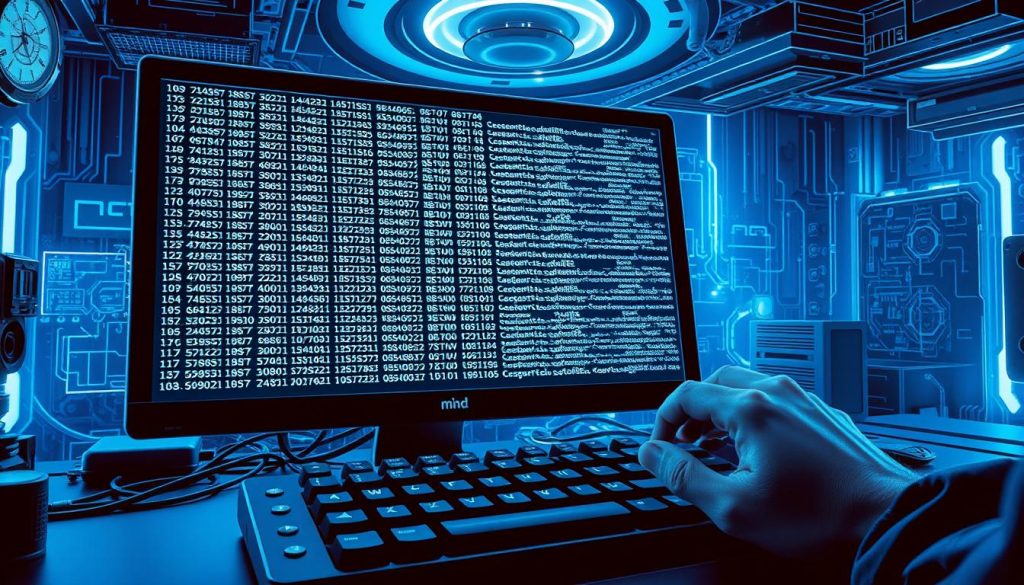
Executable disassembly is a complex process. It turns machine code into instructions we can read. Modern methods have changed how we understand compiled software.
Advanced techniques in executable disassembly use smart ways to decode complex binary structures:
- Symbolic execution for comprehensive code path analysis
- Control flow graph generation
- Data flow tracking mechanisms
- Machine learning-enhanced decompilation strategies
Experts use top tools with intelligent decoding algorithms. These tools help solve tough problems like:
- Handling obfuscated code segments
- Recovering stripped debugging information
- Reconstructing original program logic
Machine learning is making executable disassembly better. Neural networks can predict code structures and find vulnerabilities. They can also rebuild complex software with great accuracy.
The future of binary analysis lies in combining computational intelligence with deep understanding of software architecture.
Researchers keep finding new ways to decode complex binary. They are pushing the limits of software reverse engineering and security analysis.
Troubleshooting Common Decompilation Issues
Decompilers are key in rebuilding code. But, developers face many challenges. It’s vital to solve these problems for good binary analysis and software engineering.
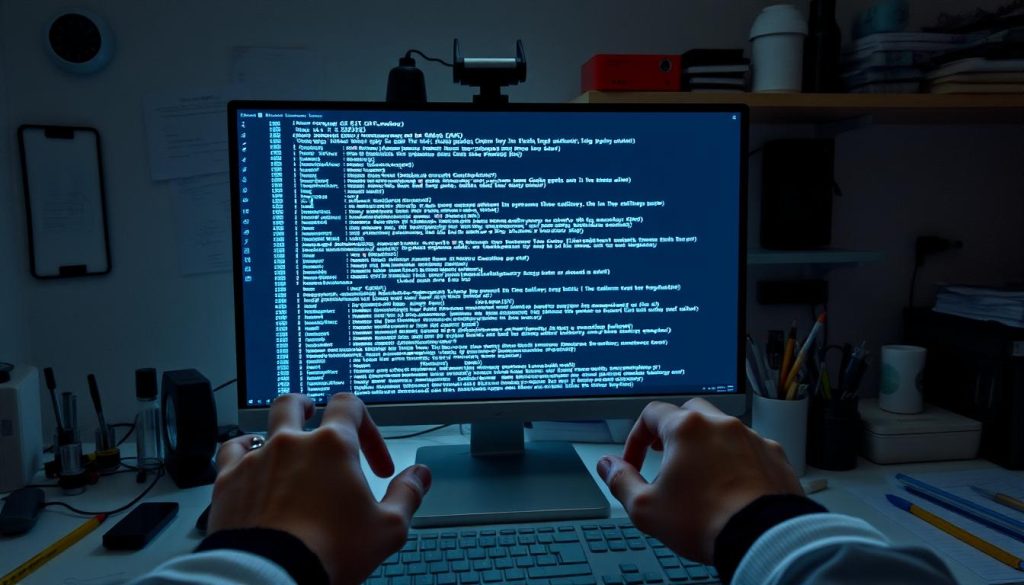
Error Handling and Resolution Strategies
Managing errors well is crucial with decompiler tools. Developers need to tackle various technical hurdles that block code rebuilding.
- Identify specific error messages and their root causes
- Use debug logging to trace decompilation problems
- Verify input binary file integrity
- Check compatibility with target decompiler version
Optimization Challenges in Code Reconstruction
Optimized binaries are hard for decompilers. Compiler optimizations can hide the original code, making it tough to rebuild.
| Optimization Type | Decompilation Impact | Mitigation Strategy |
|---|---|---|
| Inline Function Expansion | Reduces code readability | Use advanced decompiler with function recognition |
| Dead Code Elimination | Removes unused code segments | Cross-reference with original debugging symbols |
| Loop Unrolling | Complicates control flow analysis | Employ sophisticated control flow reconstruction algorithms |
Platform Compatibility Resolution
Different operating systems and architectures pose unique challenges. Developers must grasp these differences for accurate decompilation.
- Recognize calling convention differences
- Account for memory model variations
- Test decompilation across multiple platforms
- Use cross-platform decompiler tools
By using these strategies, developers can beat common decompilation hurdles. This leads to more reliable code rebuilding results.
Integration with Development Workflows
Today’s software development needs binary translation tools to work smoothly with current workflows. Developers see how important these tools are for better software security and code management.
Adding binary translation solutions to CI/CD pipelines brings big benefits:
- Automated security scanning of legacy code
- Rapid vulnerability detection
- Streamlined code maintenance processes
- Enhanced software security analysis
Tools with command-line interfaces and strong APIs make decompilation tasks easy to automate. They fit well into existing development setups, cutting down on manual work and errors in security checks.
Here are some ways to integrate:
- Use API-driven binary translation scripts
- Create custom plugins for development platforms
- Develop standard decompilation workflows
- Set up team-wide code analysis protocols
Getting integration right needs good planning, team training, and the right tools. Working together can change how teams handle code analysis and security.
Future Trends in Binary Analysis Tools
The world of binary analysis is changing fast. New technologies are making it easier for developers and security experts to work with executable unpacking and code investigation. These changes are making binary analysis tools smarter, easier to use, and safer.
Binary analysis is seeing big changes in many areas. New advancements are opening up new possibilities in executable code investigation.
AI-Powered Decompilation
Artificial intelligence is changing binary analysis with advanced machine learning. These systems can:
- Spot complex code patterns with great accuracy
- Guess code structures better
- Need less human help in decompilation
Cloud-Based Solutions
Cloud platforms are changing how we unpack executables. They offer:
- More computing power
- Analysis from anywhere
- Places to work together
Enhanced Security Features
Security in binary analysis is getting better. Next-generation tools are adding new ways to find and stop threats, like:
- Malware detection with machine learning
- Algorithms that check threats in real-time
- Better checks for executable signatures
These new trends show how binary analysis is always evolving. They promise smarter, more efficient, and safer ways to understand complex software.
Conclusion
Binary to source code converters have changed how we develop and analyze software. These tools help developers and security experts understand complex files. They give deep insights into software architecture.
The latest in machine learning and AI-driven decompilation are changing reverse engineering. They are making it better than before.
These converters are key in solving big challenges in software maintenance and security. They help teams understand and fix complex software. New technologies are making it easier and more precise to reverse engineer.
The future of binary analysis looks bright. As cyber threats grow, these tools will be vital in keeping our digital world safe. Developers and security experts need to keep up with new decompilation technologies.
Research and development in binary to source code conversion are showing great promise. With more work in machine learning, AI, and algorithms, we’ll see better tools. These tools will change how we work with complex software systems.

